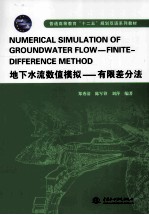
- 作 者:郑秀清,陈军锋,刘萍编著
- 出 版 社:北京:中国水利水电出版社
- 出版年份:2014
- ISBN:9787517017844
- 标注页数:119 页
- PDF页数:130 页
请阅读订购服务说明与试读!
订购服务说明
1、本站所有的书默认都是PDF格式,该格式图书只能阅读和打印,不能再次编辑。
2、除分上下册或者多册的情况下,一般PDF页数一定要大于标注页数才建议下单购买。【本资源130 ≥119页】
图书下载及付费说明
1、所有的电子图书为PDF格式,支持电脑、手机、平板等各类电子设备阅读;可以任意拷贝文件到不同的阅读设备里进行阅读。
2、电子图书在提交订单后一般半小时内处理完成,最晚48小时内处理完成。(非工作日购买会延迟)
3、所有的电子图书都是原书直接扫描方式制作而成。
Chapter 1 Introduction 1
1.1 Brief of Groundwater 1
1.1.1 Importance of Groundwater 1
1.1.2 Groundwater Resources Management 2
1.2 Process of Groundwater Modeling 3
Chapter 2 Mathematical Model of Groundwater Flow 9
2.1 Basic Concepts 9
2.2 Basic Law 12
2.2.1 Law of Energy Conservation 12
2.2.2 Law of Mass Conservation 17
2.3 Basic Equation of Groundwater Flow 18
2.3.1 Basic Equation for Steady Incompressible Flow 18
2.3.2 Basic Equation for Non-steady Compressible Flow 19
2.4 Boundary Conditions 21
2.4.1 Boundary Conditions 21
2.4.2 Initial Conditions 22
2.5 Mathematical Model 23
Chapter 3 Numerical Method—Finite-Difference Method 24
3.1 Main Ideas and Solving Steps 24
3.1.1 Main Ideas of Finite-Difference Method 24
3.1.2 Steps of Solving Groundwater Flow Problem by Difference Method 24
3.2 Finite Difference Formulae 25
3.2.1 Finite Difference Approximation 25
3.2.2 Convergence and Stability 27
3.3 Steady Flow in Confined Aquifers 27
3.3.1 1-D Steady Flow 27
3.3.2 2-D Steady Flow 34
3.4 Transient Flow in Confined Aquifers 37
3.4.1 1-D Transient Flow 37
3.4.2 2-D Transient Flow 40
3.5 Transient Flow in Unconfined Aquifers 44
Chapter 4 Introduction and Tutorial of Visual MODFLOW 48
4.1 Introduction of Visual MODFLOW 48
4.1.1 Brief Introduction of Visual MODFLOW 48
4.1.2 About the Interface 48
4.1.3 Main Menu Screen 49
4.1.4 Screen Layout 49
4.2 Instructions of Example Model 50
4.3 Creating and Defining a Flow Model 52
4.3.1 Generating a New Model 52
4.3.2 Refining the Model Grid 55
4.3.3 Adding Wells 62
4.3.4 Assigning Model Properties 63
4.3.5 Assigning Model Boundary Condition 68
4.3.6 Assigning Particles 73
4.4 Running Visual MODFLOW 74
4.4.1 Run Options for Flow Simulations 74
4.4.2 Engines to Run 75
4.5 Output Visualization 76
4.5.1 Head and Contouring Options 76
4.5.2 Velocity Vectors and Contouring Options 78
4.5.3 Pathlines and Pathline Options 80
Chapter 5 Numerical Simulation of Impervious Wall Construction of Xizhang Basin Groundwater Reservoir in Taiyuan 83
5.1 Model Objectives 83
5.2 Overviews of the Xizhang Basin 83
5.2.1 Regional Geography 83
5.2.2 Regional Geological and Hydrogeological Conditions 85
5.2.3 Social and Economic Situation 86
5.3 Conditions for the Construction of Underground Reservoir 86
5.4 Groundwater Flow Model for Xizhang Basin 87
5.4.1 Hydrogeological Conceptual Model 87
5.4.2 Establishment Groundwater Model 88
5.4.3 Identification and Calibration of the Model 92
5.5 Influences of Impervious Wall on Groundwater Flow 98
5.5.1 Input Data for Wall Boundary 98
5.5.2 Simulation Impervious Wall by Wall Boundary 98
5.5.3 Correction of Impervious Wall Parameters 98
5.5.4 Effects of Impervious Wall Construction on the Simulation of Groundwater Flow 99
Chapter 6 Application of MODPATH to Classify Protection Area in Tumen 106
6.1 Model Objectives 106
6.2 Overviews of Water Source Situation in Tumen 106
6.2.1 Geography 106
6.2.2 Regional Geological and Hydrogeological Conditions 108
6.3 Groundwater Flow Model for Tumen Water Source Area 109
6.3.1 Hydrogeological Conceptual Model 109
6.3.2 Mathematical Model for the Groundwater Flow 109
6.3.3 Model Validation 111
6.4 Delineation of Water Source Protection Zones by MODPATH 113
6.4.1 Numerical Simulation Method 113
6.4.2 Procedure of Protection Zones Delineation 114
6.4.3 Results of Protection Zones Delineation 114
References 119
